by Madeline McMahon
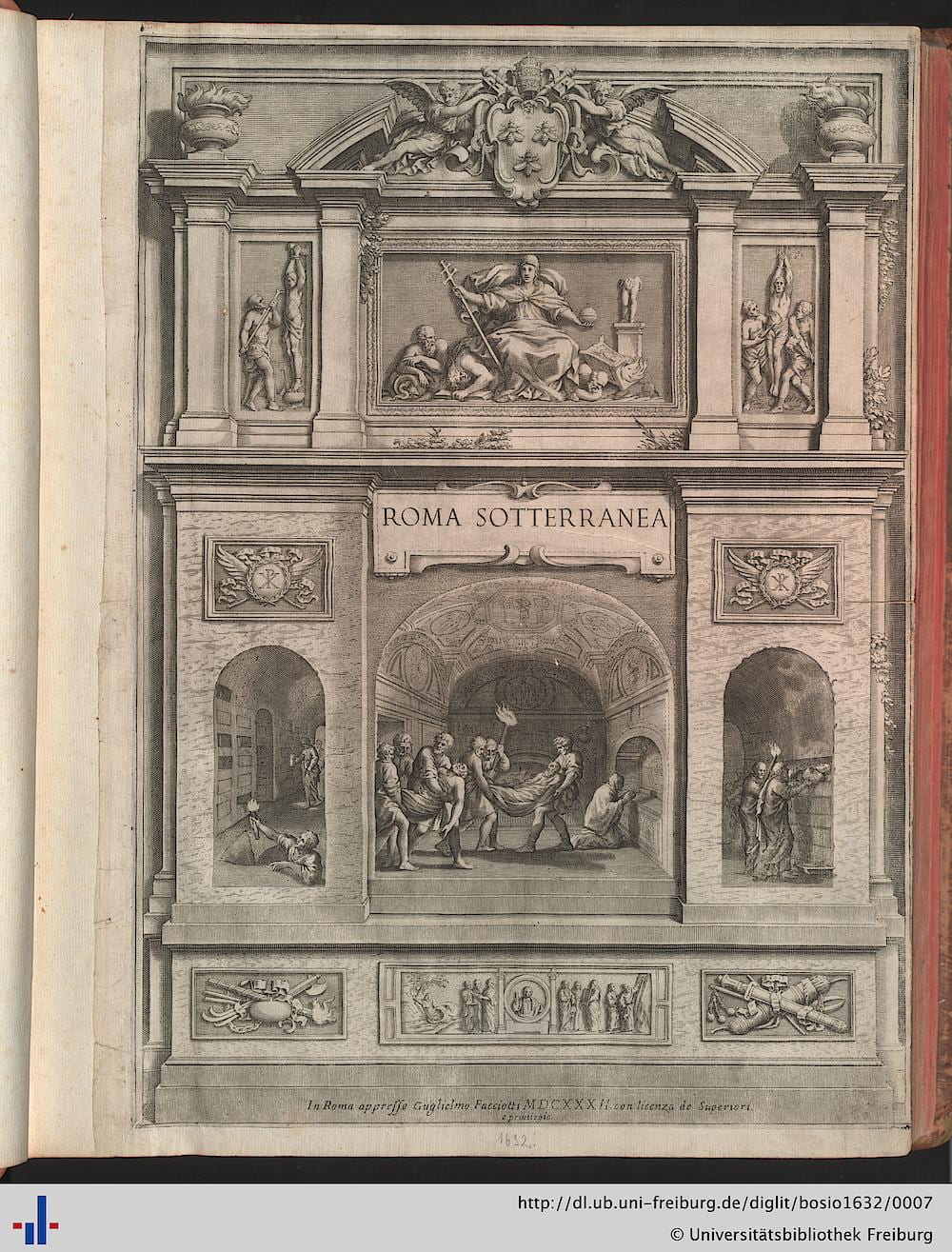 Antonio Bosio’s Roma sotterranea was published posthumously in 1634. Bosio’s original manuscript, now in the Biblioteca Vallicelliana, was finally brought to print by the Oratorian scholar Giovanni Severano. The book would have cost a fortune—it was over six hundred folio pages long and heavily illustrated—but it became enduringly popular (Simon Ditchfield, “Reading Rome,” 189). It covered much more than the underground world of the Roman catacombs for which it is now known. It detailed how the martyrs’ bones had been preserved by providence for future believers (book I) and discussed early Christian material evidence from construction sites as well as excavations proper in books II and III. But the vast majority of the visual evidence for which the book is so famous and the detailed analysis of that evidence in book IV were primarily the work of the editor Severano rather than Bosio (Ditchfield, “Text Before Trowel,” 346). Severano’s team of engravers recreated Christian sarcophagi, catacomb paintings, lamps, and inscriptions, often from multiple angles.
Antonio Bosio’s Roma sotterranea was published posthumously in 1634. Bosio’s original manuscript, now in the Biblioteca Vallicelliana, was finally brought to print by the Oratorian scholar Giovanni Severano. The book would have cost a fortune—it was over six hundred folio pages long and heavily illustrated—but it became enduringly popular (Simon Ditchfield, “Reading Rome,” 189). It covered much more than the underground world of the Roman catacombs for which it is now known. It detailed how the martyrs’ bones had been preserved by providence for future believers (book I) and discussed early Christian material evidence from construction sites as well as excavations proper in books II and III. But the vast majority of the visual evidence for which the book is so famous and the detailed analysis of that evidence in book IV were primarily the work of the editor Severano rather than Bosio (Ditchfield, “Text Before Trowel,” 346). Severano’s team of engravers recreated Christian sarcophagi, catacomb paintings, lamps, and inscriptions, often from multiple angles.
In the catacombs, as Jerome reflected dramatically in the fourth century, “So great is the darkness that the language of the prophet seems to be fulfilled—‘Let them go down quick into hell.’” How did one bring the catacombs to light in print—how did one depict the material evidence that was so often fragmentary but also charged with devotional meaning? Severano’s interests were clearly iconographical. His added fourth book addressed the typical representations of biblical figures and the symbolism used in the catacomb art. Iconography could both help and hinder understanding of early Christian art. It helped the engravers fill in destroyed or only partially visible carvings and paintings. Typically they did not call attention to it, but sometimes they did.
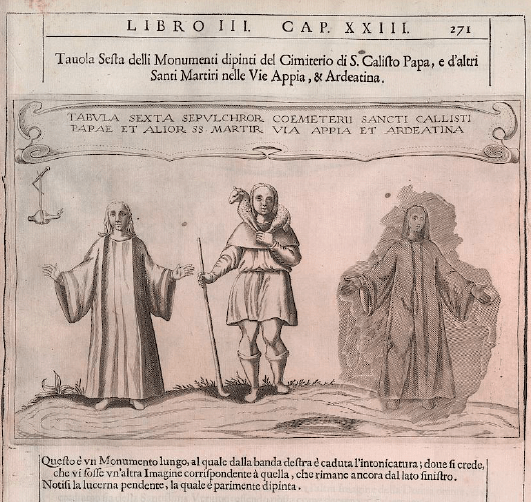
Reconstructing a damaged wall painting, with a hypothetical restoration (p. 271)
Here, for example, they have taken the liberty of showing a corresponding figure in the orans pose on the other side of good shepherd where a piece of plasterwork had fallen off. But they have also taken care to show both their addition and the damaged area. Yet their expectations for iconography could also blind them, leading them to expect the instruments of martyrdom (p. 433) or subtly shaping their depiction of a bust-length portrait of Christ (p. 253).
 The way in which they depict text is especially fascinating in light of Severano’s attempts to depict and describe early Christian iconography. As he noted in IV.31, “the ancient Christians not only represented our Lord with various images, as we have seen, but his most holy name was expressed in different mysterious ways,” including the monogram (cifra) of the Chi-Rho (p. 629), comprised of the Greek letters Χ (chi) and Ρ (rho). Letters could function like images—to such an extent that Severano included the symbol in the book’s index under “X” rather than “C,” so that befuddled readers could learn what this common sign meant.
The way in which they depict text is especially fascinating in light of Severano’s attempts to depict and describe early Christian iconography. As he noted in IV.31, “the ancient Christians not only represented our Lord with various images, as we have seen, but his most holy name was expressed in different mysterious ways,” including the monogram (cifra) of the Chi-Rho (p. 629), comprised of the Greek letters Χ (chi) and Ρ (rho). Letters could function like images—to such an extent that Severano included the symbol in the book’s index under “X” rather than “C,” so that befuddled readers could learn what this common sign meant.This awareness of text as image sometimes influenced the reproductions of epitaphs on sepulchers. Although many of the reproductions only imitated original inscriptions through their use of capital letters, Severano’s team occasionally reproduced visual elements in the text, such as the exaggerated size of T’s (probably referring to the association of the Greek letter Τ (tau) with the cross) in some (p. 300). As in the case of the praying figure on broken plaster, they also tried to indicate damage, either by replicating cracks in the stone or including ellipses in the transcription. While they frequently attempted iconographically based reconstructions of missing parts of paintings or imperfect sarcophagi, textual frammenti were left incomplete. In one instance, on a marble stone that was especially “worn out,” they simply confessed, “Il resto non si può leggere” (p. 400).
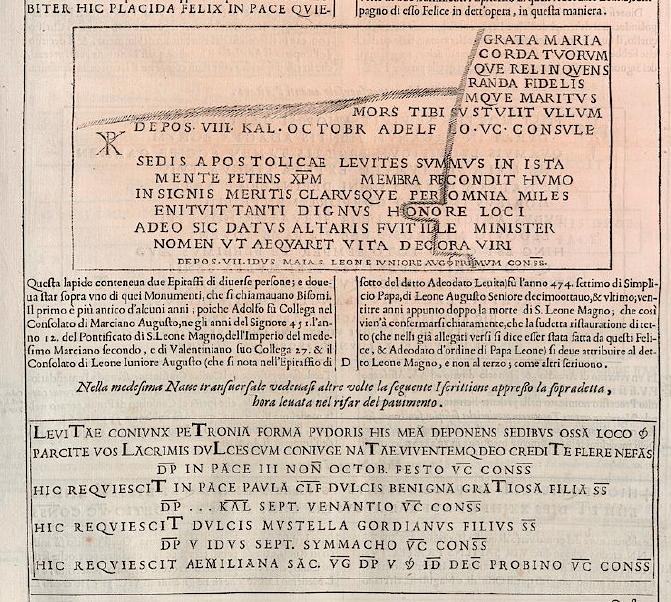
A broken inscription and an inscription with exaggerated T’s (p. 151)
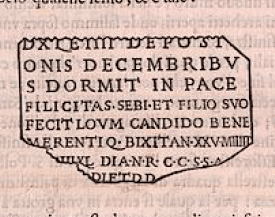 While even simple capital letters in a square are evocative of the material object they represent, there are a few instances in Roma sotterranea when Severano clearly felt that the script was integral to the artifact. One was a broken sepulchral inscription found by the Via Portuense catacombs—one of many fragments “from which one could not extract any sense” (p. 125). Perhaps its very difficulty made it necessary to reproduce with greater attention to the placement of the text on the stone. Text, with symbols like palms, doves, and the Chi-Rho, also features as part of the reconstructions of the sepulchers carved out in the catacomb walls. One page in particular includes an attempt to copy the curved, messy writing on an anonymous grave: “Rest in peace. Kalends of December” (Sabbato in pace KK decembris) (p. 214).
While even simple capital letters in a square are evocative of the material object they represent, there are a few instances in Roma sotterranea when Severano clearly felt that the script was integral to the artifact. One was a broken sepulchral inscription found by the Via Portuense catacombs—one of many fragments “from which one could not extract any sense” (p. 125). Perhaps its very difficulty made it necessary to reproduce with greater attention to the placement of the text on the stone. Text, with symbols like palms, doves, and the Chi-Rho, also features as part of the reconstructions of the sepulchers carved out in the catacomb walls. One page in particular includes an attempt to copy the curved, messy writing on an anonymous grave: “Rest in peace. Kalends of December” (Sabbato in pace KK decembris) (p. 214).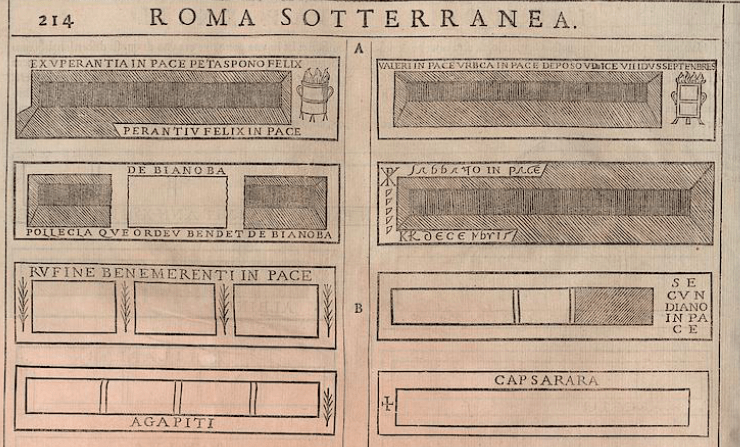
Tombs with inscriptions (p. 214)
Although Severano’s appreciation of script was not as sophisticated as his understanding of early Christian iconography, the two are not unrelated. As William Stenhouse has shown, earlier contemporaries of Bosio and Severano had begun to contextualize classical inscriptions and reproduce them to scale, differentiating between different kinds of writing. They had even made attempts to reconstruct fragmentary inscriptions. In many ways, Roma sotterranea follows these trends more closely in its engravings of catacomb paintings than in its reproductions of Christian inscriptions and epitaphs. Nonetheless, there were certain instances in which image and text were treated as one. The inhabitants of “Underground Rome” had envisioned Christ in many guises—as a Good Shepherd, as an Orpheus, and even as collections of letters. Their own writing was part of the material evidence that Bosio encountered, and these textual objects became part of a new one when Severano brought the book to press.



March 28, 2016 at 8:09 pm
Wonderful reading of the practices of scholarship visible in Roma sotterranea. What do you think of the visual impression made by the work as a whole? Irina Oryshkevich points out that it depicts an underground city more orderly, drier, and with bigger open spaces than the actual catacombs (cf Jerome’s comment, which you quote). If she’s right–and she has a point–the blindness of scholars and engravers extended beyond seeing the torture of martyrs in frescoes that did not depict them.